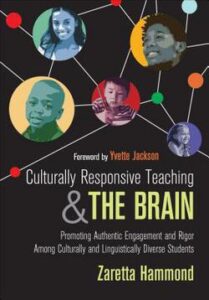Defining and Achieving Equity in the Classroom
Culturally Responsive Teaching and The Brain: Promoting Authentic Engagement and Rigor Among Culturally and Linguistically Diverse Students
By Zaretta Hammond
(Corwin, 2015 – Learn more)
Reviewed by Bill Ivey


We value Zaretta Hammond’s combination of a clear explanation of brain-based learning from a cultural perspective and a clear description of how it looks in action. While we in NENTS 2.0 work with early career teachers, I found the book on first read to also be useful to me as a late-mid career teacher, and I believe it can be useful to teachers of all ages and experiences.
The book’s structure
1. Introduction
2. Building Awareness and Knowledge
a. Climbing Out of the Gap
b. What’s Culture Got to Do with It?
c. This Is Your Brain on Culture
d. Preparing to Be a Culturally Responsive Practitioner
3. Building Learning Partnerships a-c
a. Building the Foundation of Learning Partnerships
b. Establishing Alliance in the Learning Partnership
c. Shifting Academic Mindset in the Learning Partnership
4. Building Intellective Capacity
a. Information Processing to Build Intellective Capacity
b. Creating a Culturally Responsive Community for Learning
5. Epilogue
6. Glossary
7. References and Further Reading
8. Index
Each chapter ends with three bulleted lists: a chapter summary, an invitation to inquiry, and resources to go deeper.
Awareness, Learning Partnerships, Information Processing, and Community
The first chapter introduces Zaretta Hammond’s Ready for Rigor framework: Awareness, Learning Partnerships, Information Processing, and Community of Learners and Learning Environment (pp.17-20). In explaining the framework, Hammond makes the following key points (among others!):
- In building awareness, we need to understand how the brain learns, know and own our own cultural lenses, and know and understand the three levels of culture.
- We need to rethink student and teacher relationships as a partnership, helping each student develop a sense of self-efficacy.
- We need to integrate oral traditions with other methods of information processing, and provide students with authentic opportunities to process content.
- And we need to ensure students feel safe and have voice and agency. (Hammond, p.17)
Through the book Hammond develops each of these points in greater detail, including a detailed description of the brain and how it functions. At the end of Chapter 1, we are invited to reflect on how our schools are addressing the needs of low-performing students of color, how we personally support students in becoming independent learners, and how we and our colleagues can ‘operationalize’ the principles of culturally responsive teaching (Hammond, p.20).
I found each of these reflection points to be helpful not just as a personal check on what my needs and those of my school really are, but also as a way of moving a lot of her information into longer term storage.
Looking into Individualistic and Collectivist Cultures
I also found particularly useful – both for myself and for the early career teachers with whom I was working – the information on individualism and collectivism in chapter 2 (pp.25-28), and the section on “Becoming a Warm Demander” in Chapter 6 (pp.97-99).
Examining more deeply the characteristics of individualistic cultures (such as the United States) and collectivist cultures (such as South Korea) helped me to understand more thoroughly the roots of many of the cultural differences I see in my school, and beyond.
Looking at the chart of characteristics of teachers who may be classified as warm demanders, technocrats, sentimentalists, and elitists helped me face up to aspects of my teaching personality that might, however unintentionally, undermine my effectiveness and think about what steps I could take.
Neuroscience and Culture
Every chapter in this book is useful – packed with information about neuroscience and what a truly culturally responsive approach looks like and why it is so effective. Culturally Responsive Teaching and the Brain incites teachers of all ages to reflect on how best we can support our students. No wonder it is so frequently recommended.
Bill Ivey (he/any) is Middle School Dean and teaches Humanities 7, Rock Band, and Academic Skills at Stoneleigh-Burnham School, a gender inclusive girls school for grades 7-12 in Western Massachusetts. He also serves on the NELMS Board of the Directors as an advisor for equity, inclusion, and social justice, and on the AMLE Equity in Middle Grades Education Committee. See Bill’s other MiddleWeb reviews and articles here.































